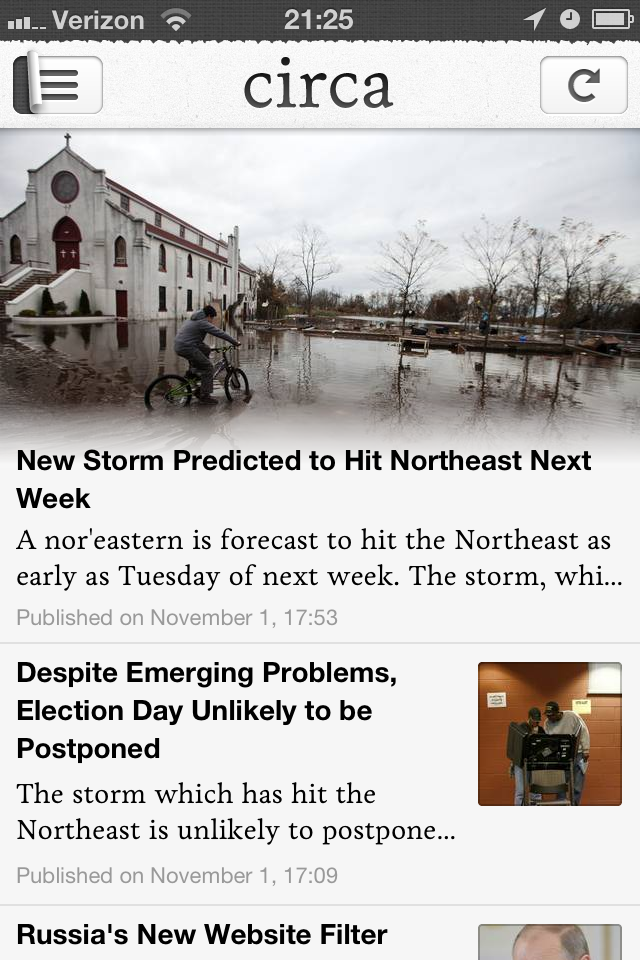“I believe in the human element of news,” says Matt Galligan, the co-founder of circa, the hot news curation app released for the iPhone a few weeks ago. Matt was speaking about circa with Founding Editor Dave Cohn, at a Hacks/Hackers meetup in San Francisco, where circa is based.
The service is quite extraordinary in how hand-crafted it feels. Optimized specifically for the mobile device, the app aggregates news into a series of snippets and photos organized by topic. Aggregate is really the wrong term because each topic is manually curated by an editor who scans their online news sources and pulls apart source material to separate fact from “fluff.”
It is the presentation which makes this app shine. The care in how the images are carefully cropped and manipulated to the clever imitation ruffled edges on the screens to emulate newsprint give the app an artful feel.
Users of the app are presented with a series of topics to read, all editorially chosen. You can dive into a topic and scan through what Matt describes as a series of cards (flash cards were an important design inspiration) which highlight key facts, quotes, images, or other information that adds to the topic. Each fact that is brought in is referenced so that the reader can drill down to the originating piece should they want to read further.
The entire experience is designed for mobile. The snippets of a story are presented like snacks that you can nibble throughout the day, while waiting for the bus, between meetings, or over coffee. It is your news, broken down.
Additionally, you can Follow a topic much as you would subscribe to an RSS feed or follow a hashtag on twitter. Big news stories such as Hurricane Sandy have “arcs” that develop over time and a key feature of circa is that you can pick up and follow any thread you want to watch closely and, if you opt in, get push notifications of updates whenever a new fact is added to any thread you are following. Following developing stories is a key use case around with circa was designed. Often when following developing stories in the mainstream media, follow on stories often include prior material for the uninitiated. Circa gathers only the new material and tacks it on to it’s thread, dropping readers where they left off.
This Follow signal is particularly interesting. A Google search or Facebook like are signals of intent but they are fleeting. When someone opts in to getting push notifications of a story, that is a very strong signal of interest that will help the circa team understand what stories to follow in the future. This symbiotic loop will help improve the service over time and the early usage and engagement figures show strong engagement that bodes well for the service and its future.
John Herrman wrote that, “Twitter is a fact-processing machine on a grand scale,” when he was describing how news about Hurricane Sandy, both real and fake, was quickly shared, distributed, and verified via tweets. Circa takes a different approach. Positioning itself as a meta-source that can be trusted, it’s editors are taking the care to pull in the most important stories of the day and updating only when something is significant. It’s a human powered approach that limits their scale but they seem ok with that.
The app was a germ of an idea in December 2011. Back then it was called Circuit and was about the “closed loop” relationship between news that is read driving an algorithm that gave you more of what interested you. They started building the app in March and launched six months later as circa, a name which reflected the evolution of the product into something which was approximately around or about the news but not necessarily in it. The formal name of the company is circa 1605, the year of the first newspaper.
The team is small. 11 editors which cover 22 of the 24 hours a day (they have an editor based in China). There are three engineers, an iOS developer, their CTO who built their custom CMS, and a third engineer working on the APIs and data. The investor team is a hot shot lineup of media wizards so they have a strong wind with lots of experience from companies such as Tumblr, Facebook, and Al Jazeera behind them.
But, as Matt shared, launch day was difficult. Just 15 minutes after their app hit the iTunes store, a rouge server took down their service and for the next four hours. Those that had the app couldn’t use it while others couldn’t download it. The team answered over 1,000 tweets and were greeted to over 100 one star reviews once they recovered. But they did recover and within the next four hours after coming online they shot up to be the #1 news app in the iTunes app store, beyond the NYT and CNN.
The app is only a few weeks old but going strong. The Follow feature has a magnetic pull to bring you back into the app as stories develop over time. The team has purposefully chosen to go after areas where their approach to curation will have maximum benefit. Big news stories such as the Election or Hurricane are perfect for circa as you can follow along with out drinking from a firehose. They are next going after the tech news vertical where the typical earnings announcement or product launch story varies little from outlet to outlet.
Monetization options remain to be seen but Matt did share that their engagement numbers are very strong and, with the Follow feature, it’ll be easy to target readers with advertising or premium subscription topics. iPhone only for now but both the circa app and the team shows promise.

Leave a Reply to Shift Media 2014 | everwasCancel reply